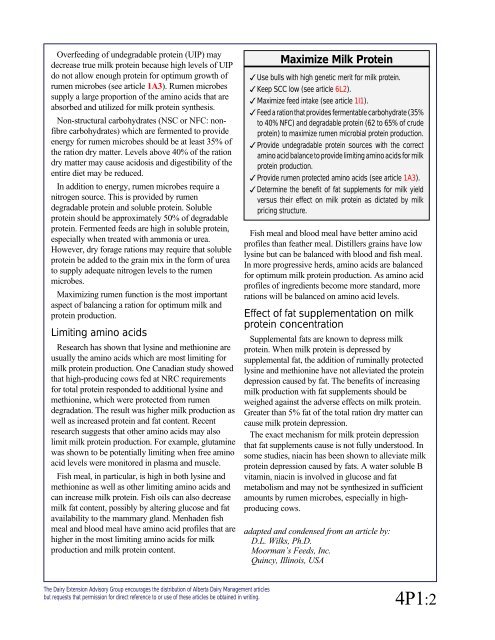ADM: Milk Protein - AgroMedia International Inc
ADM: Milk Protein - AgroMedia International Inc
ADM: Milk Protein - AgroMedia International Inc
You also want an ePaper? Increase the reach of your titles
YUMPU automatically turns print PDFs into web optimized ePapers that Google loves.
Overfeeding of undegradable protein (UIP) may<br />
decrease true milk protein because high levels of UIP<br />
do not allow enough protein for optimum growth of<br />
rumen microbes (see article 1A3). Rumen microbes<br />
supply a large proportion of the amino acids that are<br />
absorbed and utilized for milk protein synthesis.<br />
Non-structural carbohydrates (NSC or NFC: nonfibre<br />
carbohydrates) which are fermented to provide<br />
energy for rumen microbes should be at least 35% of<br />
the ration dry matter. Levels above 40% of the ration<br />
dry matter may cause acidosis and digestibility of the<br />
entire diet may be reduced.<br />
In addition to energy, rumen microbes require a<br />
nitrogen source. This is provided by rumen<br />
degradable protein and soluble protein. Soluble<br />
protein should be approximately 50% of degradable<br />
protein. Fermented feeds are high in soluble protein,<br />
especially when treated with ammonia or urea.<br />
However, dry forage rations may require that soluble<br />
protein be added to the grain mix in the form of urea<br />
to supply adequate nitrogen levels to the rumen<br />
microbes.<br />
Maximizing rumen function is the most important<br />
aspect of balancing a ration for optimum milk and<br />
protein production.<br />
Limiting amino acids<br />
Research has shown that lysine and methionine are<br />
usually the amino acids which are most limiting for<br />
milk protein production. One Canadian study showed<br />
that high-producing cows fed at NRC requirements<br />
for total protein responded to additional lysine and<br />
methionine, which were protected from rumen<br />
degradation. The result was higher milk production as<br />
well as increased protein and fat content. Recent<br />
research suggests that other amino acids may also<br />
limit milk protein production. For example, glutamine<br />
was shown to be potentially limiting when free amino<br />
acid levels were monitored in plasma and muscle.<br />
Fish meal, in particular, is high in both lysine and<br />
methionine as well as other limiting amino acids and<br />
can increase milk protein. Fish oils can also decrease<br />
milk fat content, possibly by altering glucose and fat<br />
availability to the mammary gland. Menhaden fish<br />
meal and blood meal have amino acid profiles that are<br />
higher in the most limiting amino acids for milk<br />
production and milk protein content.<br />
Maximize <strong>Milk</strong> <strong>Protein</strong><br />
3Use bulls with high genetic merit for milk protein.<br />
3Keep SCC low (see article 6L2).<br />
3Maximize feed intake (see article 1I1).<br />
3Feed a ration that provides fermentable carbohydrate (35%<br />
to 40% NFC) and degradable protein (62 to 65% of crude<br />
protein) to maximize rumen microbial protein production.<br />
3Provide undegradable protein sources with the correct<br />
amino acid balance to provide limiting amino acids for milk<br />
protein production.<br />
3Provide rumen protected amino acids (see article 1A3).<br />
3Determine the benefit of fat supplements for milk yield<br />
versus their effect on milk protein as dictated by milk<br />
pricing structure.<br />
Fish meal and blood meal have better amino acid<br />
profiles than feather meal. Distillers grains have low<br />
lysine but can be balanced with blood and fish meal.<br />
In more progressive herds, amino acids are balanced<br />
for optimum milk protein production. As amino acid<br />
profiles of ingredients become more standard, more<br />
rations will be balanced on amino acid levels.<br />
Effect of fat supplementation on milk<br />
protein concentration<br />
Supplemental fats are known to depress milk<br />
protein. When milk protein is depressed by<br />
supplemental fat, the addition of ruminally protected<br />
lysine and methionine have not alleviated the protein<br />
depression caused by fat. The benefits of increasing<br />
milk production with fat supplements should be<br />
weighed against the adverse effects on milk protein.<br />
Greater than 5% fat of the total ration dry matter can<br />
cause milk protein depression.<br />
The exact mechanism for milk protein depression<br />
that fat supplements cause is not fully understood. In<br />
some studies, niacin has been shown to alleviate milk<br />
protein depression caused by fats. A water soluble B<br />
vitamin, niacin is involved in glucose and fat<br />
metabolism and may not be synthesized in sufficient<br />
amounts by rumen microbes, especially in highproducing<br />
cows.<br />
adapted and condensed from an article by:<br />
D.L. Wilks, Ph.D.<br />
Moorman’s Feeds, <strong>Inc</strong>.<br />
Quincy, Illinois, USA<br />
The Dairy Extension Advisory Group encourages the distribution of Alberta Dairy Management articles<br />
but requests that permission for direct reference to or use of these articles be obtained in writing.<br />
4P1:2





